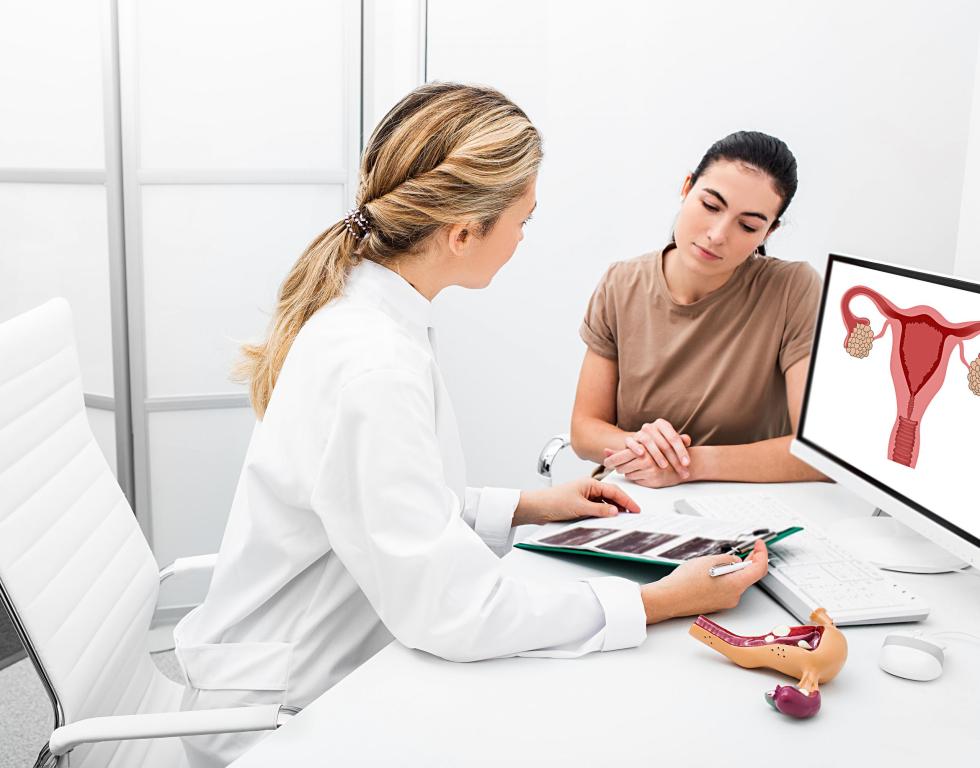
Table of Contents:
- What is Sciatica Pain?
- Causes of Sciatic Pain
- Upper Back Pain Sciatic Nerve
- What Are Uterine Fibroids?
- Schedule Treatment at USA Fibroid Centers
You’ve complained about an ache in your lower back near your hip for months. Some days, the pain can range from a sharp knife to a dull aching that won’t disappear. You continue taking over-the-counter pain medication to numb the pain, but you’re worried it could mean something more. You may be concerned about sciatic nerve pain causes and how you can treat the pain. You may also question, “How long does sciatica last?” If you’re experiencing back pain and unsure why keep reading to see if this common uterine condition could be blamed.
What is Sciatica Pain?
Sciatica pain is caused by irritation or an injury to the sciatic nerve in your low back and gluteal area. The sciatic nerve is the longest in the body, the thickest at nearly a finger’s width. The sciatic nerve runs through the hips and buttocks and down the leg, branching into other nerves below the knee.
Sciatic nerve pain may be sharp or a stabbing or shooting pain. It may cause constant pain or come and go, depending on what you’re doing, making you wonder how long does sciatica nerve pain last? The pain may worsen from sitting or standing for a long time, causing you to wonder how long does sciatica last?
Causes of Sciatic Nerve Pain
Several health conditions and behaviors can increase your risk for sciatica. If it comes on suddenly, the sciatica nerve pain may be from an injury to the lower back. However, other sciatica nerve pain causes may put you at risk of developing sciatica pain over time.
- Normal aging
- Being overweight
- Weak abdominal muscles
- Having a physical job
- Poor posture when lifting weights
- Diabetes
- Osteoarthritis
- Inactive lifestyle
- Smoking
Sciatica pain causes may include various medical conditions, such as a herniated or slipped disc. When this disc slips out of place, it can pressure the nerve root. Degenerative disc disease occurs when the discs naturally wear down over time. It can lead to spinal stenosis, which is the narrowing of the spinal canal. Since there is less space for the spinal cord and nerves in the canal, a nerve can get pinched.
Osteoarthritis can lead to sciatica if bone spurs form to compress the nerves in the lower back. Spondylolisthesis occurs when one vertebra slips out of place and narrows the opening for a nerve, causing the bone to pinch it.
How to Know If Your Sciatica Nerve Pain is Caused by Fibroids
What are sciatic nerve pain causes? There are many potential causes of sciatica pain as well as back pain other than fibroids. Some of these causes include:
- A narrowing of the spinal canal in the lower back.
- Muscle spasms in the back or buttocks area.
- A second or third-trimester pregnancy.
- If a vertebra slips forward over another vertebra.
- A breakdown of spinal discs.
- Pinched nerve that may mimic sciatica pain.
- Injury from lifting heavy objects or exercising without stretching can also mimic sciatica pain.
If you are having back or leg pain but do not have other symptoms of fibroids, you should still mention this as one of the possible sciatica nerve pain causes to your doctor to make sure they check if they aren’t able to diagnose another issue.
However, if you think fibroids could be the cause of your sciatic nerve pain or back, or leg pain, there is a nonsurgical, outpatient treatment that reduces the size of your fibroids and helps eliminate this pain.
How Fibroids Impact Surrounding Areas of the Body
If fibroids grow to be large or numerous, they can impact surrounding areas and organs in the general vicinity. Fibroids can cause frequent urination, constipation, or back pain. Because fibroids can grow outward from the uterus, or if they are located towards the back of the uterus, they can put pressure on nerves around the spinal column. If fibroids grow large and compress against the sciatic nerve, this pain can travel down to the back and legs. Fibroids can be one of the sciatica nerve pain causes.
Upper Back Pain Sciatic Nerve
Sciatica is most often diagnosed in the low back, but it can begin as high up as the L4 lumbar vertebrae. Each vertebra has a nerve root to correspond to feed to the sciatic nerve. Pain may radiate out from the area of origin. If you suffer from a painful low back, hips, or leg, you may cause additional pain from the improper posture in the middle to upper back. If you have back or leg pain, you will want to talk to your doctor about the problem to find a diagnosis for the sciatica nerve pain causes. You want to find out how long does sciatica last?
What Are Uterine Fibroids?
Uterine fibroids are among the most common reproductive diseases affecting between 70-80% of all women before 50. Fibroids are supposed to be tumors made up of fibrous connective tissue and smooth muscle cells. They range from as small as a seed to larger than a melon and can be located in various places within the uterus. The cause of fibroids is largely unknown, but it is believed that hormones play a part in why these growths develop. Certain types of fibroids may be more likely to be one of the sciatica nerve pain causes, such as those that grow outside the uterus, known as subserosal fibroids.
Some women experience severe symptoms affecting their daily lives, while others may not experience pain or discomfort. Many women may mistake their fibroid symptoms for regular period pain. It’s important to know that your period’s length, heaviness, or regularity shouldn’t negatively impact your life or be one of the sciatica pain causes. If so, it’s important to track these changes to see if fibroids could be the underlying cause.
OTHER UTERINE FIBROID SYMPTOMS INCLUDE:
- Pain during sex
- Fatigue caused by anemia
- Frequent urination
- Severe cramps or pelvic pain
- Abdominal bloating
- Constipation
- Lower back or leg pain
Every woman has a unique experience when it comes to uterine fibroids. If you’re only experiencing one of the above symptoms, it is still a good idea to get checked to see if fibroids could be the cause. Click on the button below to take our 1-minute quiz to learn more about uterine fibroid symptoms.
How are Uterine Fibroids Treated?
At USA Fibroid Centers, we treat uterine fibroids with a minimally invasive treatment option known as Uterine Fibroid Embolization (UFE). UFE offers many benefits including:
- Preserve your uterus and retain fertility.
- Avoid hospital bills and stays.
- No hormone interference.
- No general anesthesia, stitches, or scarring.
- Shorter recovery than surgeries.
- Lower risk of complications compared to invasive procedures.
- Effective at eliminating symptoms.
Many women put off getting their fibroids treated simply because they do not want major surgery. If you are hesitant about your treatment decision, it’s not right. It’s important to know that there are nonsurgical alternatives that are available.
How UFE Treats Sciatica Nerve Pain Caused by Fibroids
UFE uses the body’s natural pathways, the arteries, to administer tiny embolic agents that block the artery supplying blood and nutrients to the fibroid. Once the artery has been cut off, the fibroid will shrink on its own and eventually die. As the fibroid shrinks, you should expect relief from sciatica, lower back, or leg pain because the fibroid is no longer exerting pressure on those nerves if it was one of the sciatica nerve pain causes. You will then have the answer to how long does sciatica last?
Schedule Treatment at USA Fibroid Centers
If you are interested in learning more about UFE or want to make an appointment, call us at 855-615-2555 or click below to schedule your initial appointment today.




